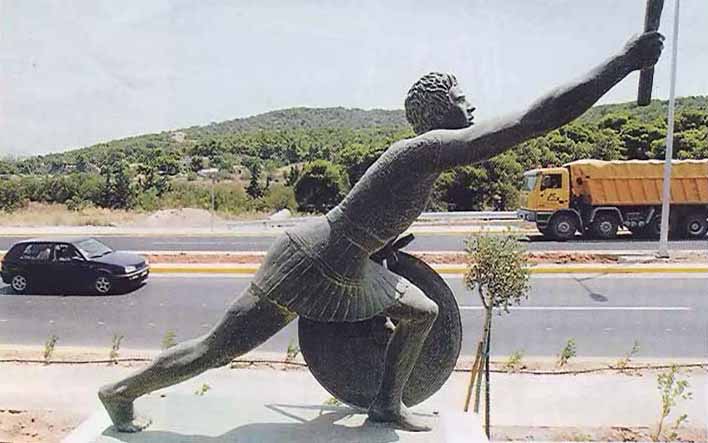The distance between Marathon and Athens is NOT a Marathon. Wait What?

Statue of Pheidippides, the famous original marathon runner along the road from Marathon to Athens.
The story of the Battle of Marathon and its connection to the modern marathon is a wonderful one, and a little bit more complicated that you might think. It also involved the British…
During the initial invasion of Greece by the Persians, under the Persian King Darius I, the two sides met in a battle at Marathon in 490BC. The smaller Athenian force was able to decisively defeat a Persian force twice their size, causing the Persians to fully retreat. It was ten years before the Persians would again try to conquer Greece. (This second invasion under Darius’s son Xerxes, is more well known in the modern public imagination with events like the 300 Spartans at the Battle of Thermopylae.)
It is here where the myth comes in.
Herodotus in his 440 BC work “The Histories” wrote of a notable messenger named Pheidippides who is said to have run from Athens to Sparta (140 miles) to ask for aid before the battle and did so in a single day. Herodotus also wrote that after the battle, the entire Athenian army marched back to Athens (25 Miles) in order to keep the retreating Persian fleet from attacking Athens.
This was 60 years after the event and this is also likely fairly close to true. The army marching 25 Miles in a day is very plausible and as far as Pheidippides, while it may not have taken him only one day to get to Sparta, there were indeed trained messengers and runners who did carry messages long distances. They wore very light cloths and no armor to make them faster.
The myth would begin to evolve over the next half millennium. Plutarch writing in the 1st century AD mentions a runner from Marathon to Athens, but changes his name, but does have the famous scene where the runner dies after giving his message of victory. While this is the oldest surviving recognizable version of the myth, Plutarch himself says he is quoting another work by Heracleides of Pontus, which is now lost. In the 2nd century the writer Lucian wrote the first known version of the standard legend with Pheidippides as the famous runner.
There are two modern versions of the myth:
The first version:
Pheidippides was a trained messenger, he ran from Athens to Sparta the day before the battle, and he ran back to Marathon the next day, then he ran from Marathon to Athens declaring “Nenikēkamen!” “We were victorious!” Then promptly dying of exhaustion. In this version Pheidippides ran 330 Miles in two days before dying of exhaustion having delivered his message.
The second version:
Pheidippides was an Athenian Soldier ordered to go to Athens and report the victory at Marathon. He ran the 25 miles fast as he could, in full armor. Once he arrived in Athens he declared “Nenikēkamen!” “We were victorious!” Then collapsed under the strain of his armor and died of exhaustion.
The exact distance of this, the very first marathon run by Pheidippides, is a topic of debate. The distance between Marathon and Athens according to Google is 30 Miles (city center to city center), depending on the road Pheidippides would have taken; his run would have been between 21 and 26 miles. A modern marathon is 26 Miles 385 yards or 26.22 Miles. While close, a standard marathon is not the distance between Marathon and Athens. Why?
The simple answer is the modern Olympics…the slightly less simple answer is…the British.
In 1896 as part of the first modern Olympic Games the organizers wanted to have a capstone event that they could connect to Ancient Greece, and having a run based on the Marathon legend was an irresistible idea. (This is also why the marathon is run at the end of the Olympic Games.) The distance was set from Marathon to the 1896 Olympic stadium in Athens, a distance of 40km, or 24.85 Miles. While not quite ending where Pheidippides’ run legendarily ended, this race did go along a route that he could have run.
As the event grew in popularity, a “marathon” was made to be a long race of about 40km, generally with a notable starting and ending point for the place that it was being run. Thus distances varied a little from race to race. In 1908 the Olympic Games were held in London. The London organizers of the games wanted to start the marathon at Windsor Castle and end it the Olympic Stadium in front of the Royal Box, a distance of 26.22 miles.
In 1921 a meeting was assembled to standardize the length of the marathon. The 1908 Olympic distance was chosen, making the actual distance of a marathon not the distance between Marathon and Athens, but the distance between Windsor Castle and the 1908 London Olympic stadium.
As a small nod to this, there is a tradition for those running a marathon at mile marker 24 to shout “God Save the Queen!” These shouts (from the runners and the crowd) are kept up for the races’ last 2.2 miles in honor of the extra distance added because of the London race.
God Save the Queen indeed!
Leave a Reply